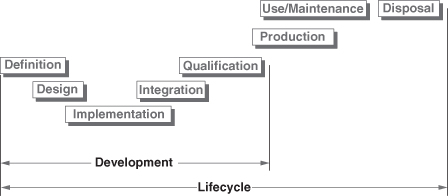B.5 CHAPTER 3: SYSTEM VVT
This chapter shall describe the specific VVT strategy adopted for the project and the resulting VVT activity planning, events and scenarios emanating from the selected VVT strategy. Finally, the VVT limitations shall be discussed.
B.5.1 VVT Strategy
This section shall describe the specific VVT strategy adopted for the project. In general, the set of VVT activities may be divided into the following three categories:
1. Preparing VVT products
2. Applying VVT to engineering products
3. Participating/conducting reviews
Appropriate VVT activities shall be performed during typical system lifecycle phases (see Figure B.3).
Figure B.3 Generic systems lifecycle phases.

Table B.3 could be considered as a CVM activity example for the VVT planners. It presents a generic (maximal) set of VVT activities, as described in this book (i.e., ID matching, Chapters 2 and 3). The VVT planner should identify a more specific set of VVT activities and then determine which VVT activities should be performed and at what performance level (0.0–1.0) they need to be performed.
TABLE B.3 CVM Activities Example for VVT Planners
| ID | VVT Activity | Performance Level |
| 2.2 | Definition phase | |
| 2.2.1 | Generate Requirement Verification Matrix (RVM) | |
| 2.2.2 | Generate VVT Management Plan (VVT-MP) | |
| 2.2.3 | Assess Request For Proposal (RFP) document | |
| 2.2.4 | Assess System Requirement Specification (SysRS) | |
| 2.2.5 ... |
Get Verification, Validation, and Testing of Engineered Systems now with the O’Reilly learning platform.
O’Reilly members experience books, live events, courses curated by job role, and more from O’Reilly and nearly 200 top publishers.

